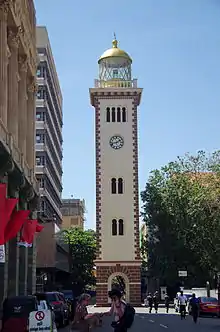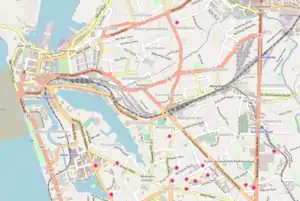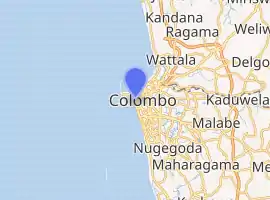Old Colombo Lighthouse
Old Colombo Lighthouse or Colombo Fort Clock Tower is a clock tower and was a lighthouse in Colombo. The lighthouse is no longer operational, but the tower remains and functions as a clock tower. It is located at the junction of Chatham Street and Janadhipathi Mawatha (formerly Queens Road) in Colombo fort.
 The clock tower lighthouse | |
 Location in central Colombo | |

| |
| Location | Fort Colombo Sri Lanka |
|---|---|
| Coordinates | 6°56′5″N 79°50′34″E |
| Year first constructed | 1829 (first) |
| Year first lit | 1865 |
| Automated | no |
| Deactivated | 1952 |
| Construction | brick tower |
| Tower shape | square tower with balcony and lantern |
| Markings / pattern | white tower with stone trim, grey metallic lantern |
| Tower height | 29 m (95 ft) |
| ARLHS number | SLI-021 |
History
.jpg.webp)
The tower was constructed as a clock tower in 1856-57 and completed on the 25 February 1857.[1] The tower was designed by Emily Elizabeth Ward, the wife of Governor Sir Henry George Ward (1797 – 1860).[1][2] The construction was undertaken by the Public Works Department, under the supervision of Mr John Flemming Churchill (Director General of Public Works). The 29-metre-high (95 ft) tower was the tallest structure in Colombo at that time.[3] The original clock was commissioned for £1,200 in 1814 by the then Governor Sir Robert Brownrigg (1759 – 1833) but was kept in a warehouse, due to economic reasons, until 1857 when it was finally installed.
The lighthouse was deactivated after its light became obscured by nearby buildings and was decommissioned on 12 July 1952.[4] The modern Galle Buck Lighthouse was erected on Marine Drive as its replacement.
Features
The original Colombo lighthouse was located on a bastion on the ocean edge of the fort, was a neo-classical structure, with a 23 m (75 ft) wooden light tower rising from a two-storey circular brick building and surrounded by an elaborate colonnade.[5] It was erected in 1829 and subsequently demolished with the removal of the fort ramparts between 1869 and 1871.[6]
The clock mechanism was constructed by the renowned English clockmakers, Dent, who were also responsible for manufacturing the clock ('Big Ben') at Westminster Palace in 1852. The clock tower was formally commissioned on 25 March 1857.[4] The bells in the clock tower consisted of a main bell of approx. 250 kg (550 lb) and two auxiliary bells of 152 kg (335 lb).
The navigational light was moved to the tower in 1867.[7] The clockwork operated revolving dioptric light was constructed by Chance Brothers. The height of the focal plane above sea-level was 140 m (460 ft) and the light was visible to an eye elevated 61 m (200 ft) above sea level at a distance of 27 km (17 mi) in clear weather. The light was a triple flash at intervals of 30 seconds, each flash being of one second duration, and each long eclipse of 18 seconds duration.[8] The light was lit using kerosene oil. In 1907 it was converted to gas. In 1933 it was replaced with a 1,500 candle power light powered by electricity.
In October 1913, the clock had to be replaced with the current clock, which has a six-foot dial glazed with opal glass for illumination and the clock tower was re-inaugurated on 4 April 1914.[4]
References
- Paranavitana, Dr. K. D. (25 June 2006). "The Big Ben of Colombo - the Chatham Street clock tower". The Sunday Times. Retrieved 8 October 2014.
- "Genealogy of Henry George Ward". Daniel Morgan's Genealogy Pages. 31 December 2010. Retrieved 8 October 2014.
- "Lighthouse Explorer: Colombo Clock Tower". Lighthouse Digest. Retrieved 8 October 2014.
- Muhaj Hamin, T.M. (4 May 1997). "Let it tick and chime again". The Sunday Times. Retrieved 9 October 2014.
- Lighthouses: Return to an Address of the Honourable The House of Commons, dated 15 April 1850. Hansard. House of Commons. 1 August 1850. p. 41.
- "Lighthouse, Colombo". The British Library. Retrieved 8 October 2014.
- Rowlett, Russ (13 February 2006). "Lighthouses of Sri Lanka". University of North Carolina at Chapel Hill. Retrieved 8 October 2014.
- Skeen, George J. A. (1906). A Guide to Colombo: With Maps; A Handbook of Information, Useful Alike. London. pp. 24–5.
External links
| Wikimedia Commons has media related to Old Colombo Lighthouse. |